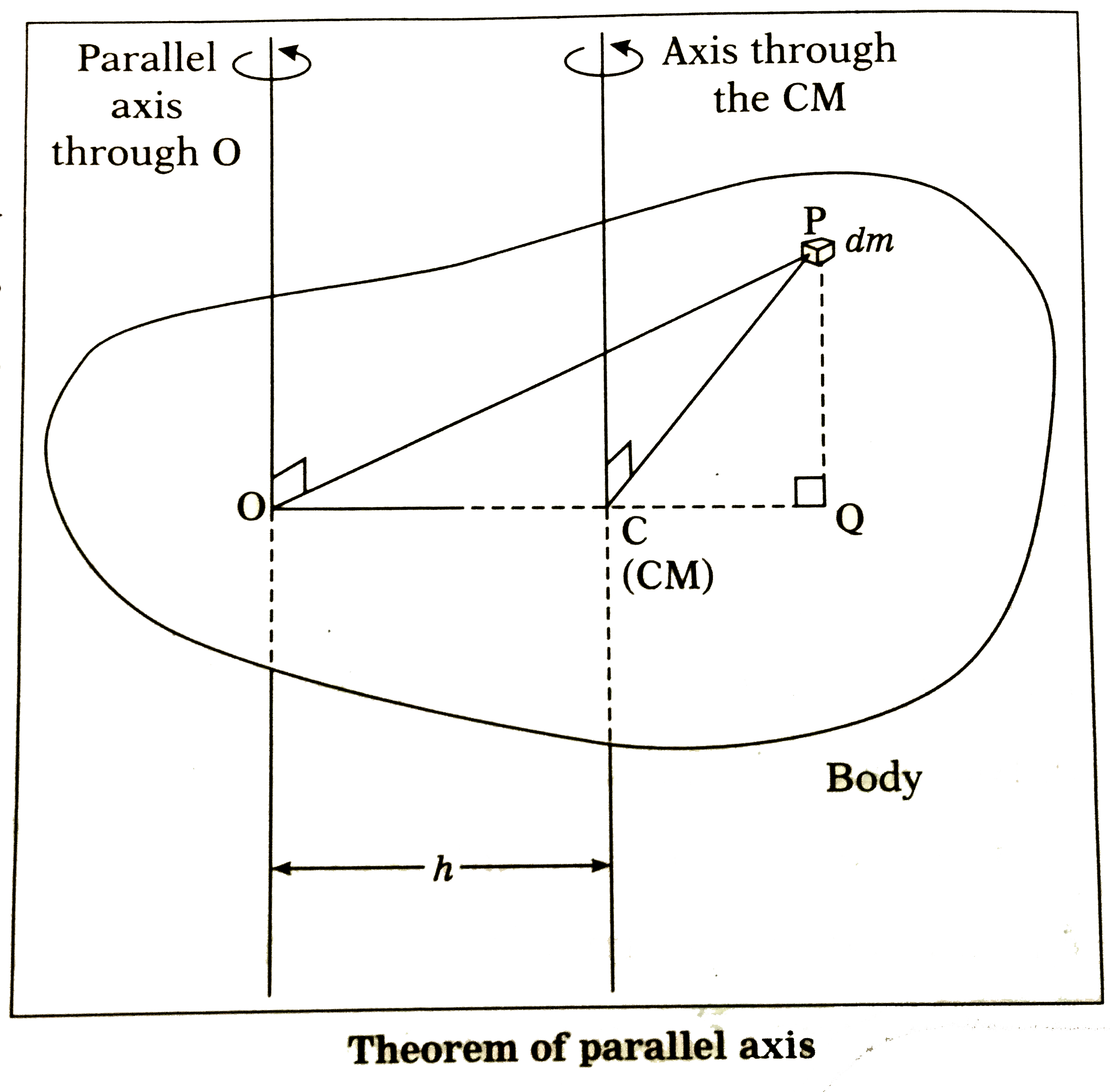State and prove theorem of parallel axes.
Video Solution
Text Solution
Theorem of parallel axis : The moment of inertai of a body about an axis is equal to the sum of (i) its moment of inertia about a parallel axis through its centre of mass and (ii) the product of the mass of the body and the square of the distance between the two axes.

Proof : ICM be the moment of inertia (MI) of a body of mass M about an axis thorugh its centre of mass C, and I be its MI about a parallel axis through any point O. If the distance between the two axes is h, them the theorem of parallel axis can be stated mathematically as
I=ICM+Mh2
Consider an infinitesimal volume element of mass dm of the body at a point P. It is at a perpendicular distance CP from the rotation axis through C and a perpendicular distance OP from the parallel axis through O.
The MI of the element about the axis through C is CP2dm. Therefore, the MI of the body about the axis through the CM is ICM=∫CP2 dm. Similarly ,the MI of the body about the parallel axis through O is I=∫OP2 dm.
Draw PQ perpendicular to OC produced as shown in the figure. Then, from the figure,
I=∫OP2 dm
=∫(OQ2+PQ2)dm
=∫[(OC+CQ)2+PQ2]dm
=∫(OC2+2OC.OQ+CQ2+PQ2)dm
=∫(OC2+2OC.CP2)dm (:'CQ2+PQ2=CP2)
=∫OC2dm+∫2OC.CQdm+∫CP2dm
=OC2∫dm+2OC∫CQdm+∫CP2dm
Since, OC=h is constant and ∫dm=M is the mass of the body,
I=Mh2+2h∫dm+ICM
Now, from the definition of centre of mass, the integral ∫CQ dm gives mass M times a coordinate of the CM with respect to the origin C. Since C is itself the CM, this coorinate is zero and so also the integral.
∴I=ICM+Mh2
This proves the theorem of parallal axis.
|
Topper's Solved these Questions
- DERIVATIONS-IBOOK - NAVNEET PUBLICATION - MAHARASHTRA BOARDCHAPTER - DERIVATIONS-IEXERCISE - Oscillations
5 Videos
- DERIVATIONS-IBOOK - NAVNEET PUBLICATION - MAHARASHTRA BOARDCHAPTER - DERIVATIONS-IEXERCISE - Elasticity
2 Videos
- DERIVATIONS-IBOOK - NAVNEET PUBLICATION - MAHARASHTRA BOARDCHAPTER - DERIVATIONS-IEXERCISE - Gravitation
7 Videos
- DEFINITIONSBOOK - NAVNEET PUBLICATION - MAHARASHTRA BOARDCHAPTER - DEFINITIONSEXERCISE - COMMUNICATION SYSTEMS
3 Videos
- DERIVATIONS-IIBOOK - NAVNEET PUBLICATION - MAHARASHTRA BOARDCHAPTER - DERIVATIONS-IIEXERCISE - Assignments
9 Videos
Similar Questions
Knowledge Check
By the theorem of parallel axes:
AI=IG−md2BIG=I+md2CI+IG=md2DIG=I−md2
(a) Prove the theorem of perpendicular axes.
(Hint : Square of the distance of a point (x, y) in the x-y plane from an axis through the origin and perpendicular to the plane is ^(x2)+y2).
(b) Prove the theorem of parallel axes.
(Hint : If the centre of mass of a system of n particles is chosen to be the origin ∑miri=0).
View SolutionState and prove Baye's theorem.
View SolutionState and prove theorem of perpendicular axes.
View SolutionState theorem of parallel axes and therom of perpendi cular axes about moment of inertia.
View SolutionAccording to the theorem of parallel axes I=Icm+Mx2, the graph between I and x will be
View SolutionState and prove Gauss's law in electrostatics.
View SolutionState Rolle’s theorem.
View Solution
